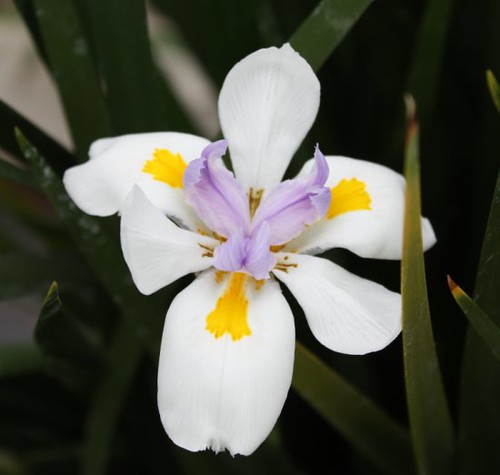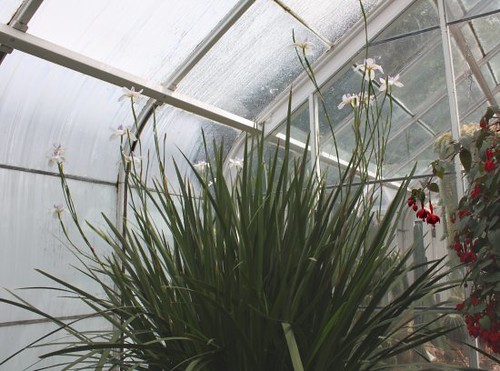While on our recent vacation to the Pacific Northwest, we visited the Volunteer Park Conservatory in Seattle, Washington. It was such a cool conservatory with so many interesting plants that it felt like I had been in charge of acquisitions! I plan to write 5+ posts on this little conservatory alone. You can look forward to posts talking about about the Marantaceae (Ctenanthe, Calathea, Maranta, Stromanthe), Carnivorous plants (Sarracenia and Nepenthes), Fuchsias, Bromeliads (including Tillandsias), Orchid Cacti (Epiphyllums), Euphorbias, and some oddballs (like Dischidia and Hydnophytum).
However, this post is about one single Iris plant - Dietes iridioides. This beautiful plant from the Iridaceae (Iris) family has very rigid leaves with the firmness of a Yucca. The plant stands tall at about 4 feet and forms a thick clump in any and all available space. It was apparent that the plant like its environment in the conservatory and since coming home I have learned that it is considered mildly invasive in the areas where it is hardy - zone 8a or greater.
I am tempted to talk my parents-in-law into buying some of these plants to use for landscaping their new property in Denton, TX, as I think it would be hardy there. Regardless, I've got to get some for myself and will keep it in a pot in my greenhouse. Seeds are very easy (and cheap) to come by on ebay, but I'm still not really confident in my seed-rearing abilities. Maybe this a plant worth the cheap experiment.
The plant is called "Fortnight Lily," "African Iris," "Cape Iris" or simply "Wild Iris" as a common name. But I imagine there are probably a good 20-30 different Iris that go by that name. The genus Dietes is native to southern and eastern Africa (including Ethiopia!), and consists of four to six species - one of which occurs outside of Africa, on an island off the coast of Australia. This particular plant (Dietes iridioides), was formerly placed in the genus Moraea, but was moved to Dietes because it is rhizomatous (it has a rhizome). I had to get help from a staff worker at the conservatory to finally find a label on one of the plants and it read "Dietes vegeta - Fortnight Lily." The wikipedia article on Dietes tells me that this plant is really Dietes iridioides and I confirmed that information with Tropicos.
There are so many different types (genera) of Iris. For a long time the only type of Iris with which I was familiar was a bearded Iris - a very common flowerbed plant in this part of the country. I've always thought they were very nice flowers. But then I discovered Dutch Iris (Iris x hollandica), which my grandmother was growing. With more slender leaves and flowers, and a deep royal blue bloom, this quickly became my favorite Iris. Just a couple of years ago I discovered Apostle Plants, or Walking Iris (Neomarica gracilis). And again my favorite Iris was trumped!
I find that every new Iris I discover quickly becomes a favorite plant of mine. Plants that are in the Iris genus are more familiar, but the "fringe" genera within the Iridaceae family are so much more interesting and beautiful to me. The Iridaceae family consists of more than 2000 unique species from 66 genera, including some not as obviously related to the common bearded Iris, like the Crocus genus. Many of these plants grow in sub-Saharan Africa (south of the Sahara desert) and quite a few in the Americas.
However, this post is about one single Iris plant - Dietes iridioides. This beautiful plant from the Iridaceae (Iris) family has very rigid leaves with the firmness of a Yucca. The plant stands tall at about 4 feet and forms a thick clump in any and all available space. It was apparent that the plant like its environment in the conservatory and since coming home I have learned that it is considered mildly invasive in the areas where it is hardy - zone 8a or greater.
 |
| Dietes iridioides bloom |
 |
| Dietes iridioides |
There are so many different types (genera) of Iris. For a long time the only type of Iris with which I was familiar was a bearded Iris - a very common flowerbed plant in this part of the country. I've always thought they were very nice flowers. But then I discovered Dutch Iris (Iris x hollandica), which my grandmother was growing. With more slender leaves and flowers, and a deep royal blue bloom, this quickly became my favorite Iris. Just a couple of years ago I discovered Apostle Plants, or Walking Iris (Neomarica gracilis). And again my favorite Iris was trumped!
I find that every new Iris I discover quickly becomes a favorite plant of mine. Plants that are in the Iris genus are more familiar, but the "fringe" genera within the Iridaceae family are so much more interesting and beautiful to me. The Iridaceae family consists of more than 2000 unique species from 66 genera, including some not as obviously related to the common bearded Iris, like the Crocus genus. Many of these plants grow in sub-Saharan Africa (south of the Sahara desert) and quite a few in the Americas.
I don't think I would mind being invaded by an iris this beautiful! :-)
ReplyDeleteLearned something new Zach. I have one of these in my backyard and I though it was a Moraea the whole time. Now I know it has been changed.
ReplyDelete